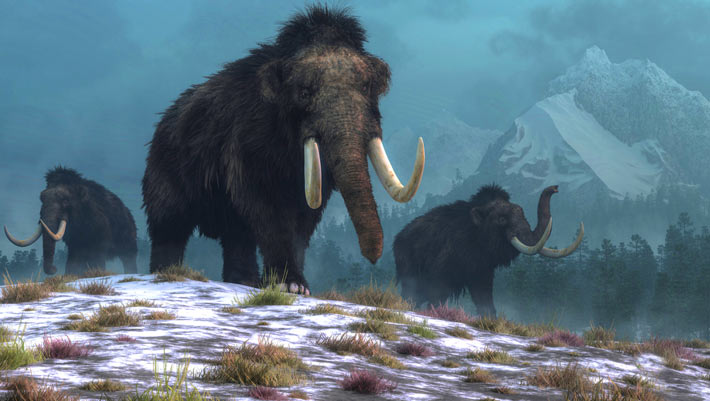Woolly mammoths (Mammuthus primigenius) became isolated on Wrangel Island off the coast of Siberia around 10,000 years ago and persisted for over 200 generations before becoming extinct around 4,000 years ago. To study the evolutionary processes leading up to their extinction, scientists analyzed 21 woolly mammoth genomes from Siberia. Their results show that the population recovered quickly from a severe bottleneck and remained demographically stable during the ensuing six millennia.
A trio of woolly mammoths (Mammuthus primigenius) trudges over snow covered hills; behind them, mountains with snow covered peaks rise above dark green forests of fir trees. Image credit: Daniel Eskridge.
“We can now confidently reject the idea that the population was simply too small and that they were doomed to go extinct for genetic reasons,” said Dr. Love Dalén, an evolutionary geneticist at the Centre for Palaeogenetics, a joint collaboration between the Swedish Museum of Natural History and Stockholm University.
“This means it was probably just some random event that killed them off, and if that random event hadn’t happened, then we would still have mammoths today.”
“In addition to shedding light on woolly mammoth population dynamics, the analysis of Wrangel Island mammoths could help inform conservation strategies for present-day endangered animals.”
“Mammoths are an excellent system for understanding the ongoing biodiversity crisis and what happens from a genetic point of view when a species goes through a population bottleneck because they mirror the fate of a lot of present-day populations,” said Dr. Marianne Dehasque, also from the Centre for Palaeogenetics.
To understand the genomic consequences of the Wrangel Island bottleneck on the mammoth population, the researchers analyzed the genomes of 21 woolly mammoths: 14 from Wrangel Island, and 7 from the mainland population that predated the bottleneck.
Altogether, the samples spanned the last 50,000 years of the woolly mammoth’s existence, providing a window into how mammoth genetic diversity changed through time.
Compared to their mainland ancestors, the Wrangel Island mammoth genomes showed signs of inbreeding and low genetic diversity.
In addition to overall low genetic diversity, they showed reduced diversity in the major histocompatibility complex, a group of genes known to play a critical role in the vertebrate immune response.
The scientists showed that the population’s genetic diversity continued to decline throughout the 6,000 years that the mammoths inhabited Wrangel Island, though at a very slow pace, suggesting that the population size was stable up until the very end.
And although the island’s mammoth population gradually accumulated moderately harmful mutations throughout its 6,000-year tenure, they showed that the population was slowly purging the most harmful mutations.
“If an individual has an extremely harmful mutation, it’s basically not viable, so those mutations gradually disappeared from the population over time, but on the other hand, we see that the mammoths were accumulating mildly harmful mutations almost up until they went extinct,” Dr. Dehasque said.
“It’s important for present day conservation programs to keep in mind that it’s not enough to get the population up to a decent size again; you also have to actively and genetically monitor it because these genomic effects can last for over 6,000 years.”
Though the mammoth genomes analyzed in the study straddle a large timespan, they do not include the final 300 years of the species’ existence.
However, the authors unearthed fossils from the mammoth’s final period and plan to conduct genomic sequencing in the future.
“What happened at the end is a bit of a mystery still — we don’t know why they went extinct after having been more or less fine for 6,000 years, but we think it was something sudden,” Dr. Dalén said.
“I would say there is still hope to figure out why they went extinct, but no promises.”
The findings were published online this week in the journal Cell.
_____
Marianne Dehasque et al. Temporal dynamics of woolly mammoth genome erosion prior to extinction. Cell, published online June 27, 2024; doi: 10.1016/j.cell.2024.05.033
>>> Read full article>>>
Copyright for syndicated content belongs to the linked Source : Breaking Science News – https://www.sci.news/paleontology/wrangel-islands-woolly-mammoths-13058.html
